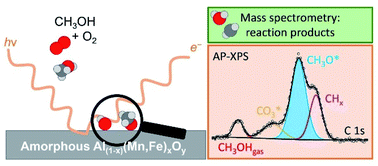Understanding methanol dissociative adsorption and oxidation on amorphous oxide films†
Abstract
Interactions between a transition metal (oxide) catalyst and a support can tailor the number and nature of active sites, for instance in the methanol oxidation reaction. We here use ambient pressure X-ray photoelectron spectroscopy (AP-XPS) to identify and compare the surface adsorbates that form on amorphous metal oxide films that maximize such interactions. Considering Al(1−x)MxOy (M = Fe or Mn) films at a range of methanol : oxygen gas ratios and temperatures, we find that the redox-active transition metal site (characterized by methoxy formation) dominates dissociative methanol adsorption, while basic oxygen sites (characterized by carbonate formation) play a lesser role. Product detection, however, indicates complete oxidation to carbon dioxide and water with partial oxidation products (dimethyl ether) comprising a minor species. Comparing the intensity of methoxy and hydroxyl features at a fixed XPS chemical shift suggests methanol deprotonation during adsorption in oxygen rich conditions for high transition metal content. However, increasing methanol partial pressure and lower metal site density may promote oxygen vacancy formation and the dehydroxylation pathway, supported by a nominal reduction in the oxidation state of iron sites. These findings illustrate that AP-XPS and mass spectrometry together are powerful tools in understanding metal–support interactions, quantifying and probing the nature of catalytic active sites, and considering the link between electronic structure of materials and their catalytic activity.

- This article is part of the themed collection: Photoelectron spectroscopy and the future of surface analysis


 Please wait while we load your content...
Please wait while we load your content...
